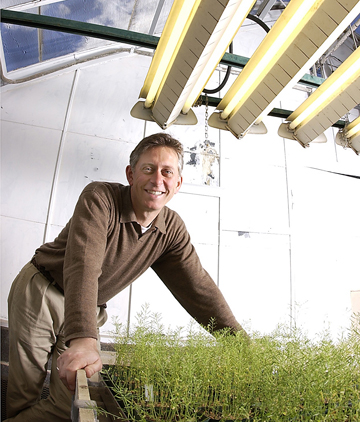Never-before-seen plant metabolites discovered
August 23, 2012
 |
|
Clint Chapple |
WEST LAFAYETTE, Ind. – Purdue University researchers have captured evolution in action through the discovery of a new set of metabolites synthesized by Arabidopsis plants, according to research findings published this week in the journal Science.
Clint Chapple, distinguished professor of biochemistry; former Purdue graduate student Jing-Ke Weng; current Purdue graduate student Yi Li; and Huaping Mo, associate director of the Purdue Interdepartmental NMR Facility, were studying how new metabolic pathways evolve in plants when they discovered the metabolites, which they are calling arabidopyrones. Many different metabolites are used by plants for defense, pigmentation and to attract pollinators, while others are used by humans as pharmaceuticals and flavorings.
Arabidopyrones are found only in Arabidopsis, a common research plant, although it's unclear what the metabolites do.
"Understanding plant metabolism is critical to being able to understand how plants evolve and adapt to their environment, and, in an applied sense, having access to the genes involved in plant metabolism helps us manipulate those processes and harness them for our own use," Chapple said.
Arabidopsis diverged from its common ancestor with related plants such as cabbage and canola about 40 million years ago. Since then, many Arabidopsis genes have been duplicated. When that happens, Chapple said, one copy of the gene typically continues to perform its previous function, while the other is free to mutate and acquire new properties and functions. One such duplication enabled Arabidopsis to begin making the new compounds Chapple and his group discovered.
"This is an example of how nature experiments with chemistry. If that new gene becomes useful to the plant because the new compounds help the plant survive in some way or reproduce more effectively, there is selection for the gene and it is maintained," Chapple said.
The way these compounds are made is reminiscent of how beets make their red pigments. But these compounds are made from the amino acid tyrosine; whereas, arabidopyrones originate instead from phenylalanine, an amino acid plants use to make floral scent compounds, antioxidants and lignin. The newly evolved enzyme Chapple's group discovered reroutes some of the material flowing through these pathways and channels it toward other enzymes that complete the transformation to arabidopyrones.
"This is how plants acquire the ability to make new compounds," Chapple said.
The National Science Foundation funded the research.
Writer: Brian Wallheimer, 765-496-2050, bwallhei@purdue.edu
Source: Clint Chapple, 765-494-0494, chapple@purdue.edu
ABSTRACT
Assembly of an Evolutionarily New Pathway for α-Pyrone Biosynthesis in Arabidopsis
Jing-Ke Weng, Yi Li, Hauping Mo, Clint Chapple
Plants possess arrays of functionally diverse specialized metabolites, many of which are distributed taxonomically. Here, we describe the evolution of a class of substituted a-pyrone metabolites in Arabidopsis, which we have named arabidopyrones. The biosynthesis of arabidopyrones requires a cytochrome P450 enzyme (CYP84A4) to generate the catechol-substituted substrate for an extradiol ring-cleavage dioxygenase (AtLigB). Unlike other ring-cleavage-derived plant metabolites made from tyrosine, arabidopyrones are instead derived from phenylalanine through the early steps of phenylpropanoid metabolism. Whereas CYP84A4, an Arabidopsis-specific paralog of the lignin-biosynthetic enzyme CYP84A1, has neofunctionalized relative to its ancestor, AtLigB homologs are widespread among land plants and many bacteria. This study exemplifies the rapid evolution of a biochemical pathway formed by the addition of a new biological activity into an existing metabolic infrastructure.
Ag Communications: (765) 494-2722;
Keith Robinson, robins89@purdue.edu
Agriculture News Page

